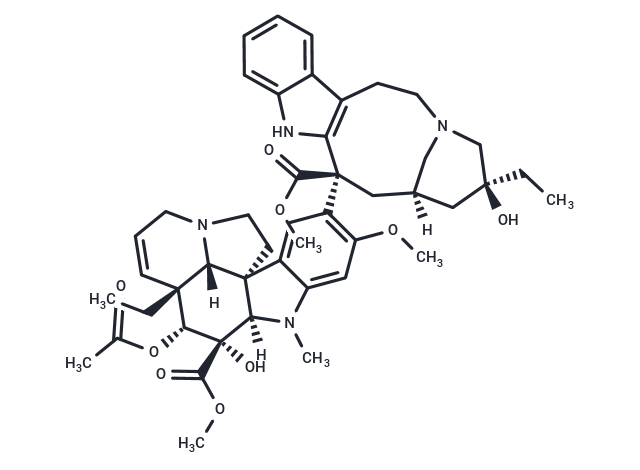Shopping Cart
- Remove All
 Your shopping cart is currently empty
Your shopping cart is currently empty

Vinblastine inhibits microtubule formation and suppresses nAChR activity with IC50 of 8.9 μM, used to treat certain kinds of cancer.

| Pack Size | Price | Availability | Quantity |
|---|---|---|---|
| 10 mg | $54 | In Stock | |
| 50 mg | $126 | In Stock | |
| 100 mg | $216 | In Stock | |
| 200 mg | $302 | In Stock | |
| 1 mL x 10 mM (in DMSO) | $54 | In Stock |
| Description | Vinblastine inhibits microtubule formation and suppresses nAChR activity with IC50 of 8.9 μM, used to treat certain kinds of cancer. |
| Targets&IC50 | nAChR:8.9 μM |
| In vitro | Vinblastine does not depolymerize spindle microtubules, yet it powerfully blocks mitosis (for example, IC50 0.8 nM in HeLa cells) and cells die by apoptosis[2]. In NB4 cells, vinblastine produces alteration of p53 and DNA fragmentation. Vinblastine treatment has an antiproliferative effect via the induction of apoptosis producing Bax/Bcl-2 imbalance. Vinblastine treatment suppresses NFκB expression and depresses NFκB-DNA binding activity while maintaining JNK activation that subsequently results in apoptotic response through caspase-dependent pathway[3]. Vinblastine is found to trigger apoptosis as evidenced by the loss of mitochondrial membrane potential, the release of both cytochrome c and apoptosis inducing factor, activation of caspase-9 and 3, and cleavage of Poly (ADP-ribose)-Polymerase[4]. |
| In vivo | Vinblastine is a widely used anticancer drug with undesired side effects. Its conjugation with carrier molecules could be an efficient strategy to reduce these side effects[5]. |
| Cell Research | Six-well treatment plates are set up that contained 5 × 104 cells/mL in each well, suspended in 3 mL culture medium, and these are treated with vinblastine for 3 h followed by 21 h growth. (Only for Reference) |
| Molecular Weight | 810.97 |
| Formula | C46H58N4O9 |
| Cas No. | 865-21-4 |
| Smiles | [H][C@@]12N3CC[C@@]11c4cc(c(OC)cc4N(C)[C@@]1([H])[C@](O)([C@H](OC(C)=O)[C@]2(CC)C=CC3)C(=O)OC)[C@]1(C[C@@]2([H])CN(C[C@](O)(CC)C2)CCc2c1[nH]c1ccccc21)C(=O)OC |
| Relative Density. | 1.37 g/cm3 |
| Storage | store at low temperature | Powder: -20°C for 3 years | In solvent: -80°C for 1 year | Shipping with blue ice. | |||||||||||||||||||||||||||||||||||
| Solubility Information | Ethanol: 6 mg/mL (7.4 mM), Sonication is recommended. DMSO: 42 mg/mL (51.79 mM), Sonication is recommended. | |||||||||||||||||||||||||||||||||||
Solution Preparation Table | ||||||||||||||||||||||||||||||||||||
Ethanol/DMSO
DMSO
| ||||||||||||||||||||||||||||||||||||

Copyright © 2015-2025 TargetMol Chemicals Inc. All Rights Reserved.